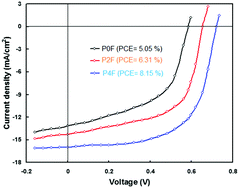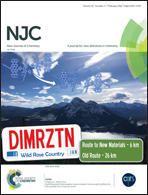Polymer solar cells based on D–A low bandgap copolymers containing fluorinated side chains of thiadiazoloquinoxaline acceptor and benzodithiophene donor units†
Abstract
Three ultralow-bandgap D–A copolymers (P0F, P2F and P4F) based on fluorene-substituted thiadiazoloquinoxaline acceptor and BDT donor units were synthesized and characterized. The effect of the number of fluorine atoms substituted in the fluorene side chain on the optical, electrochemical, crystalline and photovoltaic properties of copolymers was compared. The results showed that the optical properties and lowest unoccupied molecular orbital energy levels of the copolymers are almost the same with an increase in fluorine atoms in the side chain, while the highest occupied molecular orbital (HOMO) energy level is shifted downward. P4F and P2F show better light harvesting abilities, higher crystallinities and low-lying HOMO energy levels than those of P0F. These copolymers were used as donors along with PC71BM as an acceptor for the bulk heterojunction polymer solar cells and optimized by adjusting the donor-to-acceptor weight ratios and solvent vapor treatment. Polymer solar cells based on optimized active layers based on P4F and P2F deliver a power conversion efficiency of 8.15% and 6.38%, respectively, which are higher than that of P0F counterpart (5.04%) due to an increase in all photovoltaic parameters, i.e., short circuit current, open circuit voltage and fill factor, and a very low voltage loss of 0.44 eV.



 Please wait while we load your content...
Please wait while we load your content...